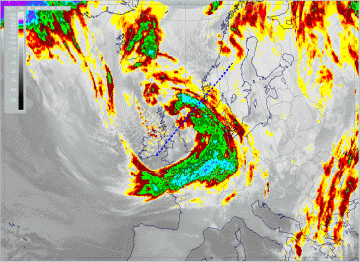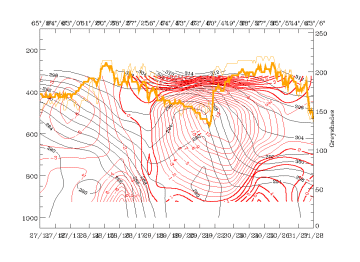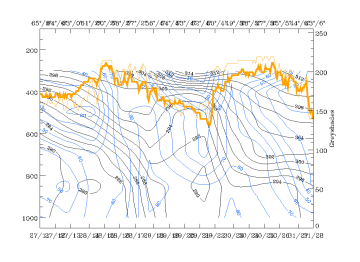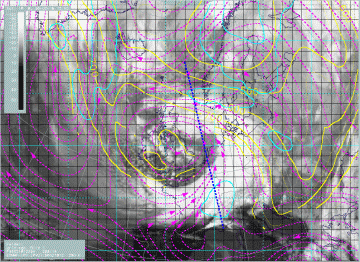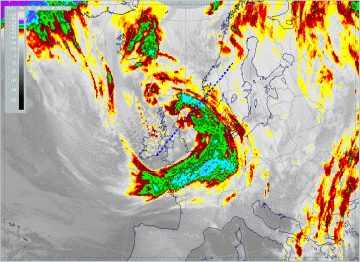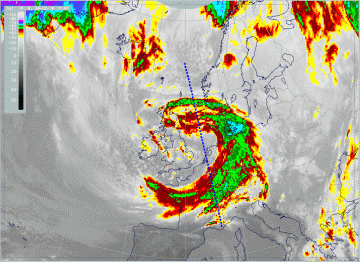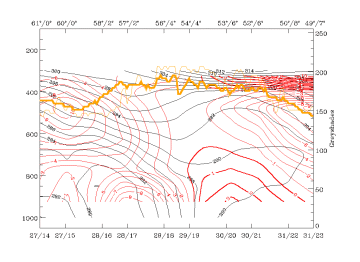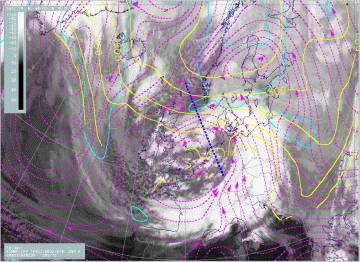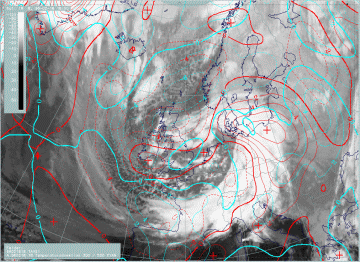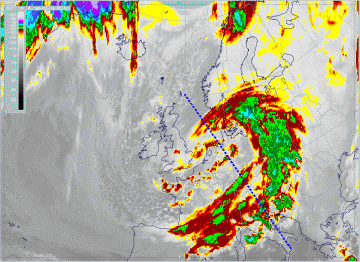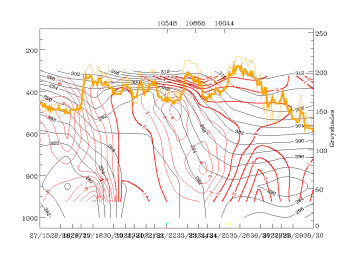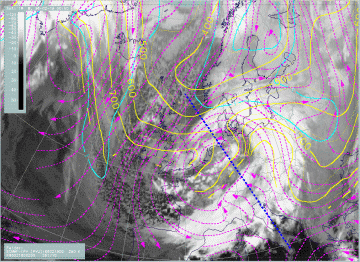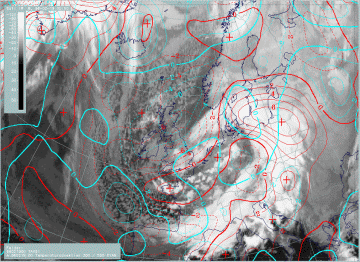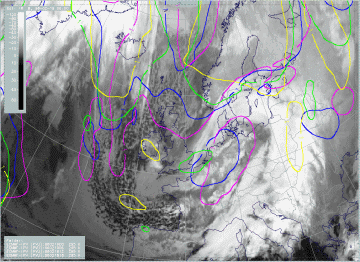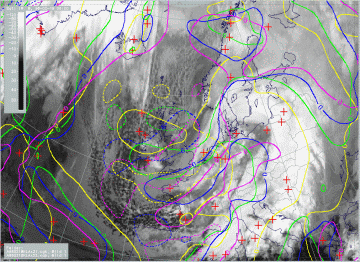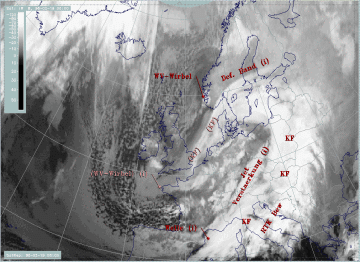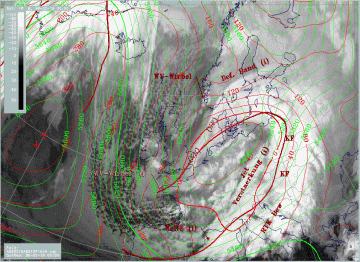18 - 19 February 1996 - Forecast For "special Investigation": 18 February 12.00 UTC To 19.00 February 06.00 UTC
|
18 February 1996/18.00 UTC - Meteosat IR enhanced image; position of vertical cross section indicated
|
18 February 1996/06.00 UTC - Meteosat IR enhanced image; position of vertical cross section indicated
|
Two changes can be noticed: The cloud band of the Occlusion under discussion has moved southward as a whole without showing any notable changes in cloudiness, and the orientation of the vertical cross section is aligned more north-south crossing also the main Cold Front cloudiness.
|
18 February 1996/12.00 UTC - Vertical cross section; black: isentropes (ThetaE), red thin: temperature advection - CA, red thick:
temperature advection - WA, orange thin: IR pixel values, orange thick: WV pixel values
|
18 February 1996/12.00 UTC - Vertical cross section; black: isentropes (ThetaE), blue: relative humidity, orange thin: IR pixel values,
orange thick: WV pixel values
|
The isentropes clearly show two Cold Front zones with the distinct northern one inclined downward from about 400 hPa to the surface, reaching it close to 56N/04E which is on the southward edge of the cloud spiral. The appearance is very typical for a Cold Front with high humidity and WA on top of the frontal crowding zone of isentropes, and very dry air within the zone of high gradients. There is an area of less than 20% within the frontal zone around 500 hPa with a tongue of drier values reaching down to about 650 hPa. Compared to the relevant 06.00 UTC cross section (compare Diagnosis for 18 February 06.00 UTC ) considerable sinking of this dry air has taken place within these six hours. Compared to the TA for 12 UTC this dry air coincides with an area of CA.
The same two surfaces as for 06.00 UTC are selected for this point of time: 290K immediately on top of the frontal crowding zone, and 300K which is in the upper part of the troposphere.
|
18 February 1996/12.00 UTC - Meteosat IR image; magenta: relative streams 290K - system velocity 298° 14 m/s, yellow: isobars,
cyan: potential vorticity 290K, ECMWF grid superimposed, position of vertical cross section indicated
|
18 February 1996/12.00 UTC - Meteosat IR image; magenta: relative streams 300K - system velocity 298° 14 m/s, yellow: isobars,
cyan: potential vorticity 300K, ECMWF grid superimposed, position of vertical cross section indicated
|
The relative streams and their orientation to each other are very similar to 06.00 UTC: in 290K a relative stream from the south-east crosses the vertical cross section with weak rising east of it but changing to sinking west of it. A stream from north and north-east approaches this relative stream along the northern boundary of the cloud band. PV shows dry stratospheric air which is transported with sinking motion towards the cloud band. Looking at the vertical cross section on top of the 290K isentrope it can be noticed that the 500 hPa level coincides exactly with a minimum of less than 20% in the humidity field and is very close to the minimum in the CA field.
Also at the high 300K level the main configuration of relative streams is similar to 06.00 UTC, with a humid stream from the back of the Cold Front and a very dry stream from northern directions forming a limiting stream line to the cloud band. In addition to the 06.00 UTC situation, a saddle point now appears in this relative stream over south-west Norway. The branch crossing the vertical cross section is from regions with very high PV values (blue) in the north bending westwards along the northern edge of the cloud spiral.
|
18 February 1996/12.00 UTC - Meteosat IR image; red: temperature advection 1000 hPa, cyan: temperature advection 500 hPa
|
|
The CA mentioned several times in the interpretation of the vertical cross section can also be followed in relation to the satellite image. Red lines are temperature advection in the layer 500/1000 hPa, cyan lines in the layer 300/500 hPa. Both layers show the advection of cold air north of the cloud spiral.
In comparison to the situation at 06.00 UTC, the advection of dry and cold air on the northern side of the Occlusion band has intensified, but no notable changes have taken place between these two times.
18 February 18.00 UTC
|
18 February 1996/06.00 UTC - Meteosat IR enhanced image; position of vertical cross section indicated
|
18 February 1996/12.00 UTC - Meteosat IR enhanced image; position of vertical cross section indicated
|
In the satellite image an important change compared to 12.00 UTC has happened now. There is a clear cyclonic curvature of the cloud band under consideration towards the northern area which is the area of the advection of dry and cold air. This is now a typical appearance of a Cold Front.
|
18 February 1996/18.00 UTC - Vertical cross section; black: isentropes (ThetaE), red thin: temperature advection - CA, red thick:
temperature advection - WA, orange thin: IR pixel values, orange thick: WV pixel values
|
18 February 1996/18.00 UTC - Vertical cross section; black: isentropes (ThetaE), blue: relative humidity, orange thin: IR pixel values,
orange thick: WV pixel values
|
The frontal zone formed by the isentropes is much more flat now, being inclined from around 500 hPa down to the surface at about 55N/04E, which is very close to the southern edge of the cloud band. Dry and cold air has not only moved downwards but also in a southward direction along the cross section line, which means that the air masses on top of as well as somewhat further away from the frontal zone are now involved in the physical processes.
|
18 February 1996/18.00 UTC - Meteosat IR image; magenta: relative streams 290K - system velocity 291° 12 m/s, yellow: isobars,
cyan: potential vorticity 290K, position of vertical cross section indicated
|
18 February 1996/18.00 UTC - Meteosat IR image; magenta: relative streams 295K - system velocity 291° 12 m/s, yellow: isobars,
cyan: potential vorticity 295K, position of vertical cross section indicated
|
The relative streams in the two isentropic surfaces 290K and 295K (300K is already too high for this stage of development) are very similar. There is a main wet stream from south-east to south-west which is rising in the eastern part of the cloud band and a dry stream from the north with a limiting stream line between the two streams close to the northern boundary of the cloud band. This northern dry stream originates from areas higher than 400 hPa with PV values indicative of stratospheric air which has (as will be shown at the end of this chapter) protruded southward.
Compared with a classical Cold Front (compare Conceptual Models: Cold Front - Meteorological physical background ) there is a very similar situation now with two different humid and converging streams, but in the case of a classical Cold Front, both streams would originate from western not eastern directions, unlike the case here where an Occlusion band is transformed into a new Cold Front.
|
18 February 1996/18.00 UTC - Meteosat IR image; red: temperature advection 1000 hPa, cyan: temperature advection 500 hPa
|
|
Maxima of CA over Scotland for 500/1000 hPa and west of Norway for 300/500 hPa indicate the propagating cold air. Without knowing the history of this case such a distribution of relative streams could not be expected.
19 February 00.00 UTC
At 19 February 1996/00.00 UTC the process continues and the relevant parameter distribution can be followed easily from the discussions up to now.
|
19 February 1996/00.00 UTC - Meteosat IR enhanced image; position of vertical cross section indicated
|
|
|
19 February 1996/00.00 UTC - Vertical cross section; black: isentropes (ThetaE), red thin: temperature advection - CA, red thick:
temperature advection - WA, orange thin: IR pixel values, orange thick: WV pixel values
|
19 February 1996/00.00 UTC - Vertical cross section; black: isentropes (ThetaE), blue: relative humidity, orange thin: IR pixel values,
orange thick: WV pixel values
|
|
19 February 1996/00.00 UTC - Meteosat IR image; magenta: relative streams 290K - system velocity 261° 10 m/s, yellow: isobars,
cyan: potential vorticity 290K, position of vertical cross section indicated
|
19 February 1996/00.00 UTC - Meteosat IR image; magenta: relative streams 295K - system velocity 261° 10 m/s, yellow: isobars,
cyan: potential vorticity 295K, position of vertical cross section indicated
|
The fields of CA in the two layers still show increasing CA with maxima over central and north England.
|
19 February 1996/00.00 UTC - Meteosat IR image; red: temperature advection 1000 hPa, cyan: temperature advection 500 hPa
|
|
Evolution from 18 February 06.00 UTC to 19 February 06.00 UTC
In this process of the change of an Occlusion cloud band into a Cold Front the propagation of PV values typical for stratospheric air and CA was essential. The next two images summarize this movement from 18 February 12.00 UTC until 19 February 06.00 UTC. Different colours represent different points of time: yellow: 18/12.00 UTC, green: 18/18.00 UTC, blue: 19/00.00 UTC and magenta: 19/06.00 UTC. The isoline with a PV value of one unit which separates tropospheric from stratospheric air moves from south Norway south-westwards to Scotland and central England.
CA maxima show up as dashed lines in the same colours as just mentioned. Attention has to be drawn to the area of the British Isles. A CA maximum moves from north of Scotland (small yellow circle) to south England and the English Channel, widening and increasing.
|
19 February 1996/06.00 UTC - Meteosat IR image; yellow: potential vorticity 18/12.00 UTC, green: potential vorticity 18/18.00 UTC, blue:
potential vorticity 19/00.00 UTC, magenta: potential vorticity 19/06.00 UTC
|
19 February 1996/06.00 UTC - Meteosat IR image; yellow: temperature advection - CA 18/12.00 UTC, green: temperature advection - CA
18/18.00 UTC, blue: temperature advection - CA 19/00.00 UTC, magenta: temperature advection - CA 19/06.00 UTC
|
Diagnosis for 19 February 06.00 UTC
|
19 February 1996/06.00 UTC - Meteosat IR image; SatRep overlay: names of conceptual models
|
|
According to the SatRep manual up to now where cloud systems are diagnosed as conceptual models with typical key parameters from numerical model output, the cloud band between south Sweden and the coast of the Netherlands would have been analysed as a Cold Front predominantly because of its appearance in the satellite image. This is indicated by the rose colour and the brackets in connection with the name "KF" (Cold Front), in comparison to the red colour which is used if a conceptual model is fulfilled in all the different key parameter fields. This is not the case for this study because there are a lot of deviations from the classical Cold Front situation which are a consequence of the different evolution of this system. The next two images show that the new Cold Front is on the rear side of a dominant low pressure system, which is a sign for the transformation of an Occlusion into a Cold Front. An additional insight into the structure of the troposphere can be derived from the combination of thickness, thermal front parameter and temperature advection. There are two cold air troughs: one behind the main Cold Front over central Europe and a second, newly developed one behind the transformed Cold Front over the North Sea and the British Isles. The cyclonic curvature of the TFP and of the zero line of temperature advection along the west European coast are another indication for the process discussed in this special investigation.
|
19 February 1996/06.00 UTC - Meteosat IR image; red thick: front indicator, red: height contours 1000 hPa, green: height contours 500
hPa, SatRep overlay: names of conceptual models
|
19 February 1996/06.00 UTC - Meteosat IR image; red thick: front indicator, blue: thermal front parameter (TFP), green: equivalent
thickness 500/850 hPa, red: temperature advection - WA 1000 hPa, SatRep overlay: names of conceptual models
|

